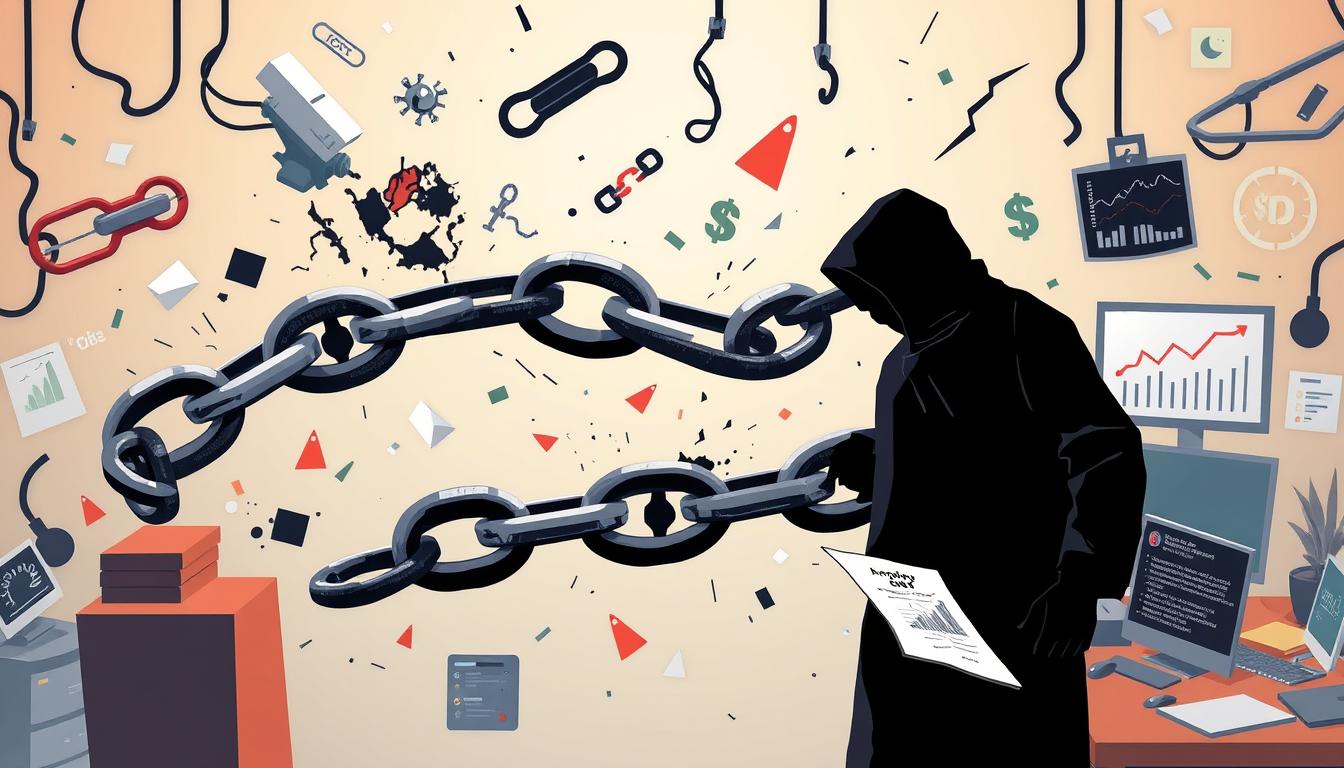
In the world of cybersecurity, a supply chain attack is a clever tactic. It uses weaknesses in trusted third-party networks. These attacks hit the web of software and hardware suppliers, using the complex links that today’s companies depend on.
A supply chain attack sneaks into a company by taking over a trusted vendor or service. Hackers know that by going after these connected systems, they can hit many targets at once. This makes their job easier and more effective.
CrowdStrike‘s research shows a worrying trend: 84% of cybersecurity experts think supply chain attacks will be a big problem in the next three years. This highlights how advanced and damaging these attacks can be.
The impact of these attacks is huge. With software projects often having 203 dependencies, one weak spot can affect many users and systems. This can lead to a chain reaction of security issues.
Key Takeaways
- Supply chain attacks exploit trusted vendor relationships
- Interconnected digital ecosystems increase vulnerability
- 45% of organizations experienced at least one software supply chain attack recently
- These attacks can impact thousands of downstream customers
- Continuous vendor risk assessment is key to stopping them
Understanding Supply Chain Attacks in Modern Cybersecurity

The digital world has changed how we see cybersecurity. Now, software supply chain attacks are a big threat. These attacks target the complex networks of technology.
Experts say supply chain attacks are getting more complex. There’s been a huge jump in these attacks, showing how smart hackers are getting.
Definition and Basic Concepts
A software supply chain attack happens when hackers get into a company’s network through a trusted vendor. They use this trust to get past the usual security checks.
- Targets critical infrastructure and software development processes
- Leverages trusted relationships between vendors and organizations
- Exploits vulnerabilities in third-party software components
The Evolution of Supply Chain Threats
Hackers are getting better at cyber espionage. They see the value in attacking software supply chains. These attacks have been around for a while, but they’re getting worse.
| Year | Attack Characteristics | Impact |
| 1984-2010 | Limited scope and complexity | Minimal organizational disruption |
| 2010-2020 | Increased sophistication | Significant financial losses |
| 2020-Present | Advanced persistent threats | Potential national security implications |
Key Components at Risk
Companies face many risks in their supply chains. Critical vulnerabilities often come from unexpected places, like:
- Software development tools
- Third-party service providers
- Open-source software repositories
- Hardware component manufacturers
The complexity of modern supply chains creates unprecedented cybersecurity challenges that require continuous vigilance and adaptive strategies.
It’s scary to know that 79% of companies have faced a supply chain attack in the last year. This shows how important it is to have strong security plans.
The Anatomy of a Supply Chain Attack

Supply chain attacks are complex cyberattacks that use trusted relationships between companies and its vendors. They inject malware and tamper with code to get into digital systems.
The attack goes through several stages:
- Initial vendor compromise
- Stealthy infiltration of trusted software components
- Strategic code tampering
- Widespread system penetration
Attackers target software development environments to inject malicious code. They use trusted channels to spread malware across many organizations.
“Supply chain attacks increased by 78% in 2019, showing how cyber threats are getting smarter.” – Symantec Research
The SolarWinds incident is a great example. Attackers got into the software build process, affecting up to 18,000 customers. This showed how a single weak spot in a trusted vendor can cause big problems.
Common vulnerabilities include:
- Weak vendor security protocols
- Insufficient code validation processes
- Inadequate software dependency management
- Limited monitoring of third-party integrations
Knowing these attack points is key to strong cybersecurity against supply chain threats.
Common Attack Vectors in Supply Chain Security
Supply chain security is a key area in modern cybersecurity. It’s where many vulnerabilities can pop up from unexpected places. Companies face new, complex threats that target both software and hardware.

Cybersecurity experts have identified the main attack vectors. These threats can harm vendor security and lead to open-source vulnerabilities:
- Software supply chain infiltration points
- Hardware component compromise mechanisms
- Third-party service provider security gaps
Software Supply Chain Vulnerabilities
Software supply chains are complex and challenging. Threats can come from inside or outside an organization. Attackers often target software dependencies to get unauthorized access.
“The cumulative effect of supply chain vulnerabilities can be compared to the ‘swiss cheese model’ – multiple small weaknesses can create significant security risks.”
Hardware Component Compromises
Hardware attacks are also a big concern. Malicious actors might add compromised parts during making or shipping. This can open backdoors for unauthorized access.
Third-Party Service Provider Risks
More companies are using outside service providers. This adds to security challenges. The Okta data breach and MOVEit attack show how bad credentials can spread vulnerabilities.
- Over 620 organizations impacted in recent supply chain attacks
- Critical authentication bypass vulnerabilities discovered
- Malware distributed through seemingly legitimate software channels
To fight these threats, strong security steps are needed. This includes constant monitoring and detailed Security Bills of Materials (SBOM).
Major Supply Chain Attack Incidents

The world of cyber espionage has changed a lot in recent years. Supply chain attacks are now a big threat to software safety. From 2019 to 2022, these attacks grew by 742%, showing big weaknesses in our digital world.
Some big incidents show how bad these attacks can be:
- SolarWinds Attack (2020): Hit 18,000 organizations
- ASUS Live Update Breach: Affects about 1 million computers
- MOVEit Transfer Tool Attack: Hit over 620 organizations
The money lost in these attacks is huge. The average cost of a data breach is $4.45 million. Experts think this could go up to $138 billion by 2031.
| Attack Incident | Organizations Affected | Financial Impact |
| SolarWinds | 18,000+ | 11% average revenue loss |
| MOVEit Transfer | 620+ | Estimated $50M damages |
| ASUS Live Update | 1 million computers | Widespread data exposure |
These attacks show we need strong cybersecurity and to always watch our software supply chains. We must use strict checks and keep software integrity to fight off these smart cyber attacks.
The complexity of modern supply chain attacks demands a proactive, multilayered defense strategy.
Supply Chain Attack Detection Methods
Detecting supply chain attacks needs a smart mix of new tech and watchful eyes. Companies must find ways to spot security issues early. This helps prevent big problems later on.

Experts say keeping software and vendor security tight is key. Yet, many companies face a big challenge. They don’t fully see what’s happening in their digital world. This makes them easy targets for sneaky attacks.
Early Warning Signs
- Unexpected system behavior changes
- Odd network traffic patterns
- Unapproved talks with outside hosts
- Strange ways software parts work together
Monitoring and Assessment Tools
New tools are vital for spotting supply chain threats. Companies can use several ways to get better at security:
| Detection Method | Effectiveness | Key Benefits |
| Threat Intelligence Platforms | 85% detection accuracy | Tracks threats in real-time |
| Behavioral Analytics Systems | 70% risk finding | Finds odd behavior |
| Endpoint Protection | 50% attack cut | Keeps a close eye on everything |
Incident Response Protocols
Good incident response needs to be quick and planned. Cybersecurity teams must have fast plans to limit damage from attacks. Detection is not just about technology, but about creating a culture of vigilance and rapid response.
Some numbers show why finding supply chain attacks early is so important. About 70% of attacks come from bad third-party software. Yet, only 20% of companies check their vendors often enough.
- Keep watching things closely all the time
- Check vendors regularly
- Have solid plans for when things go wrong
- Use the latest tools for finding threats
The Rising Threat of Software Supply Chain Attacks

The software supply chain is now a major battleground in cybersecurity. Recent data shows a shocking increase: software supply chain attacks have jumped by 742% every year. This puts organizations at high risk.
Here are some key statistics that show how complex modern software ecosystems are:
- 90% of companies use open-source software
- 97% of commercial codebases use open-source components
- 70-90% of today’s application stacks include pre-existing open-source software
Today’s software projects have an average of 203 dependencies. This creates a chain of vulnerabilities. A single compromised dependency can spread risk to many organizations.
“The interconnected nature of software development has turned every dependency into a security breach point.” – Cybersecurity Expert
The financial damage is huge. Gartner says 45% of global organizations will face a supply chain attack by 2025. This is three times the number in 2021. The financial loss is expected to grow from $40 billion in 2023 to $138 billion by 2031.
Managing open-source vulnerabilities is now key for organizations. They need to tackle software supply chain risks to stay safe.
Impact on Business Operations and Security
Supply chain attacks are a big threat to businesses today. They can cause a lot of damage and disrupt operations. These attacks can harm a company’s systems and data in many ways.

The cost of these attacks is huge. In 2024, about 183,000 customers worldwide were affected. This puts a big economic risk on the companies that were hit.
Financial Consequences
Businesses face big money problems when their supply chains are attacked:
- Data breach costs keep going up
- They can lose more than $2.3 billion in revenue
- They also have to pay to fix the problem
Reputational Damage
Supply chain attacks also hurt a company’s reputation. When a company can’t keep customer data safe, trust is lost. This can be hard to get back.
“Supply chain attacks target processes, not just systems. They leave lasting damage that’s hard to fix.”
Operational Disruption
| Industry | Attack Frequency | Potential Impact |
| Manufacturing | High Risk | Production Delays |
| Healthcare | Critical Vulnerability | Service Interruption |
| Defense | Targeted Attacks | Intellectual Property Compromise |
Supply chain attacks can disrupt business. They can hit up to 18,000 companies at once. Being ready and watching for threats is key to avoiding these problems.
Supply Chain Attack Prevention Strategies
Stopping supply chain attacks needs a mix of vendor security and software integrity. Companies must create detailed plans to cover all tech areas. This helps prevent weaknesses.
CrowdStrike suggests a strong defense that uses many layers:
- Use systems that detect attacks based on behavior
- Build strong threat intelligence
- Keep monitoring to stay ready
Important steps to prevent attacks include:
- Zero Trust Architecture: Check every connection request
- Do thorough checks on vendors
- Do regular security checks on software
“Assume breach” mentality is key for strong cybersecurity.
Using AI and blockchain can boost software safety. About 99% of automated cybercrime can be stopped with multifactor authentication, Microsoft found.
Focus on these areas to stop supply chain attacks:
- Keep watching attack surfaces
- Limit who has access to important accounts
- Train employees well on cybersecurity
Companies must stay alert. Supply chain attacks are smart and keep getting better. Being proactive, always learning, and having flexible security plans are vital. They help keep vendors safe and protect important systems.
Vendor Security Assessment and Management
In today’s world, keeping vendors secure is key to protecting companies. Half of all data breaches happen through vendors. So, it’s vital to have strong security checks and management.

Managing risks from third-party vendors is tough. Only 36% of companies check their suppliers for security each year. This leaves many gaps in their supply chain.
Due Diligence Processes
Doing a good job of checking vendors means following a few important steps:
- Comprehensive security questionnaires
- On-site security audits
- Penetration testing
- Background verification
Continuous Monitoring Approaches
Checking vendor security is not just a one-time thing. It’s an ongoing task. Companies need to keep watching for risks all the time.
| Monitoring Technique | Frequency | Risk Level |
| Quarterly Security Reviews | Every 3 Months | Medium |
| Automated Risk Scanning | Monthly | High |
| Annual Complete Audit | Yearly | Critical |
Risk Mitigation Techniques
To manage vendor security well, you need to know how to reduce risks. Important steps include:
- Setting strict security rules in contracts
- Using detailed access controls
- Working together on incident responses
- Using vendor risk scores
Vendor security is not about eliminating all risks, but intelligently managing and mitigating possible vulnerabilities.
By focusing on vendor security checks, companies can lower their risk of supply chain attacks. This helps protect their important digital assets.
Building Resilient Supply Chain Security

Protecting the software supply chain is now a top priority for companies everywhere. With 80% of data breaches caused by software supply chain issues, it’s vital for businesses to have strong security plans. They need to reduce risks and create solid security systems.
Key parts of a strong supply chain security plan include:
- Using code tampering detection tools
- Setting up strict vendor risk checks
- Creating multiple security layers
- Keeping an eye on things all the time
By being proactive, companies can lower supply chain risks. Studies show that good software supply chain security can cut data breach risks by up to 75%.
Important steps for making supply chains more resilient are:
- Doing regular security checks
- Using automated tools to scan dependencies
- Keeping detailed records of software components
- Setting high standards for vendor security
With 93% of companies saying continuous vendor risk monitoring speeds up response times, investing in top-notch security tech is key. Companies using AI for vendor risk checks can spot anomalies 70% better.
The Role of Threat Intelligence in Prevention
Threat intelligence is now a key defense against advanced cyber attacks. It uses advanced monitoring to catch and stop malware injection early. This helps protect important systems from harm.
Effective threat intelligence includes:
- Global sensor networks spanning 40+ countries
- Automated risk detection systems
- AI-driven technological solutions
- Comprehensive digital footprint management
Experts say sharing threat intelligence boosts an organization’s defense. Automated systems are very good at finding risks. They can spot up to 90% of unusual network activities.
“Threat intelligence provides early warnings and actionable insights into emerging cyber threats.” – CrowdStrike Cybersecurity Research Team
Using AI in cybersecurity has shown big improvements. It helps find and fix risks faster. Studies show threat intelligence can cut down incident resolution time by up to 50%.
Good threat intelligence helps spot and fix vulnerabilities before they become problems. This includes:
- Exposed credentials (30% of risks)
- Unsecured domains (20% of risks)
- Outdated software systems (25% of risks)
Sharing threat intelligence and doing regular risk checks helps build a strong defense. This protects against advanced cyber threats and keeps digital infrastructure safe.
Best Practices for Supply Chain Defense
Defending against supply chain attacks needs a detailed plan. With 70% of companies facing security issues in the last year, strong protection is vital. It helps keep software safe and reduces risks from open-source vulnerabilities.
Security Controls Implementation
Good security controls stop unauthorized access and breaches. Important steps include:
- Using multi-factor authentication for admin accounts
- Setting strict access rules
- Encrypting sensitive data
- Keeping software up to date
Employee Training Programs
Human mistakes cause about 80% of security breaches. Training programs help by teaching employees about:
- Spotting security threats
- Secure software development practices
- Identifying digital threats
- Quickly reporting security issues
Incident Response Planning
A solid incident response plan lessens damage from attacks. Companies should create:
- Clear communication plans
- Recovery steps
- Threat assessment tools
“By 2025, Gartner predicts that 45% of organizations will have experienced a software supply chain attack” – showing the need for strong defense.
Organizations must keep improving their defenses. They should stay alert to new threats and keep software standards high. Regular checks, proactive monitoring, and flexible security strategies are essential for fighting off complex supply chain threats.
Future Trends in Supply Chain Security
The world of software supply chain security is changing fast. New technologies and clever cyber attacks are pushing companies to work harder to keep their digital spaces safe. They face tough challenges in fighting off complex threats.
Here are some important trends in supply chain security:
- Advanced AI-powered threat detection systems
- Quantum computing-resistant security frameworks
- Enhanced Software Bill of Materials (SBOM) implementations
- Zero-trust architectural approaches
Experts say we’ll see big changes in how we defend against cyber threats. Artificial intelligence and machine learning will play a big role in spotting and fixing software supply chain problems. With more attacks from nation-state hackers, companies need to get better at protecting themselves.
“The future of supply chain security lies in proactive, intelligence-driven defense mechanisms that anticipate and neutralize threats before they can cause damage.” – Cybersecurity Research Institute
Rules and regulations are also changing. The Biden Administration’s plan to tackle cybersecurity threats names hostile nation-states as the main enemies. Companies will need to follow stricter rules and do detailed security checks.
As tech gets better, so will cybersecurity spending. In 2024, budgets for cybersecurity will go up by 6%. This shows how important it is to have strong defenses against software supply chain attacks.
Companies must stay alert and keep their security up to date. They need to use new technologies to fight off the latest cyber threats.
Conclusion
The digital world has made supply chain attacks a big problem for businesses. In 2021, these attacks tripled, showing a serious issue that needs quick action. Now, keeping vendors secure is key to a company’s survival.
One weak link can cause big problems for a whole business. The SolarWinds and NotPetya attacks show how vulnerable supply chains are. These attacks can cost millions and hurt customer trust a lot.
To fight these attacks, a complete plan is needed. This includes checking vendors, watching for threats, and having a plan for when attacks happen. The Biden Administration’s focus on this in May 2021 shows how important it is.
As technology gets better, so will cyber threats. Businesses must stay alert, use the latest threat info, and focus on security. By understanding and fighting supply chain attacks, companies can protect their digital world from new dangers.